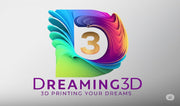Imagine walking into a pharmacy, not to pick up a bottle of mass-produced pills, but to have your medication printed for you on the spot, perfectly tailored to your body's unique needs. It sounds like science fiction, but this reality is unfolding right now, thanks to the revolutionary technology of 3D printing. We're moving beyond printing plastic toys and entering an era of personalized, on-demand medicine that could change healthcare forever. 💊
What Exactly is 3D-Printed Medicine?
At its core, 3D printing, or additive manufacturing, builds a three-dimensional object layer by meticulous layer from a digital file. Think of it like an incredibly precise inkjet printer, but instead of ink, it uses specialized materials—and instead of a flat page, it builds a solid object.
In pharmaceuticals, this process involves printing a porous, layered drug tablet. A powdered medication is laid down, and a liquid binder is "printed" on top to fuse it together in a specific shape. This process is repeated until the pill is complete. The first-ever 3D-printed drug approved by the FDA was Spritam (levetiracetam), an epilepsy treatment, back in 2015. Its highly porous structure allows it to dissolve almost instantly with a sip of water, a huge benefit for patients who have difficulty swallowing.
The Superpowers of a Printed Pill
So, why go through the trouble of printing medicine? The benefits are transformative, moving us from a one-size-fits-all approach to something far more personal and efficient.
✨ Ultimate Personalization: Today, a 100-pound person and a 250-pound person might be prescribed the same standard dose. 3D printing shatters this limitation. Doctors can prescribe a dose tailored to a patient's exact weight, age, and metabolic rate. The geometry and layers of the pill can even be adjusted to control the drug's release rate—some layers dissolving quickly for immediate effect, others slowly for a steady dose.
💊 The "Polypill": Many people, especially the elderly, face a complex daily regimen of multiple medications. 3D printing allows for the creation of a "polypill," where several different drugs are printed into a single, multi-layered tablet. Each layer contains a different medication, simplifying routines, reducing the chance of missed doses, and dramatically improving patient adherence.
🚀 On-Demand and On-Location: Imagine a hospital running low on a critical drug during an emergency, or a remote clinic needing a specific medication that's hard to stock. With 3D printing, pharmacies and hospitals could one day print drugs on-demand. This would decentralize manufacturing, strengthen supply chains, and make it easier to get life-saving medicine to isolated or disaster-stricken areas.
Challenges on the Road Ahead
While the future is bright, it's not without its hurdles. The biggest challenges are regulation and quality control. Mass manufacturing has decades of established safety protocols, and regulators need to develop new frameworks to ensure every single printed pill is safe and effective. The cost of the specialized "bio-inks" and printers is also a factor, but like all technology, prices are expected to fall as innovation continues.
The Pharmacy of Tomorrow
The era of personalized medicine is no longer a distant dream. 3D printing is poised to fundamentally reshape how we develop, manufacture, and prescribe medication. It promises a future where your treatment is as unique as your fingerprint, where complex pill schedules are a thing of the past, and where life-saving drugs can be produced anywhere, anytime.
The next time you swallow a pill, take a moment to think: in a few years, that very pill might be printed just for you.
